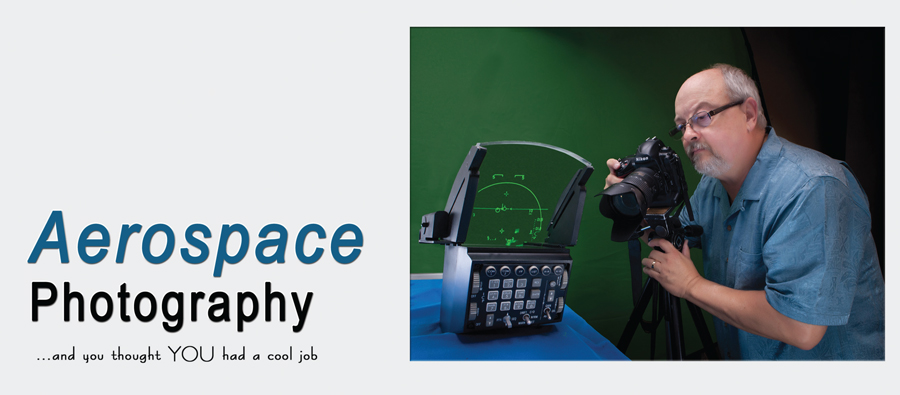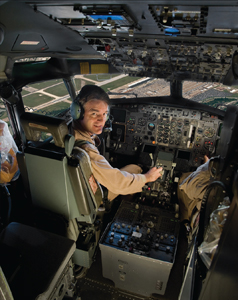 John Wilson is one lucky photographer! In addition to running his own studio in Ft. Worth, Texas, he is also a full-time photographer for the world’s largest defense contractor, Lockheed Martin. It’s a rewarding and challenging career and, for 40 years, John has witnessed history in the making while playing a critical role in the defense of our nation.
John Wilson is one lucky photographer! In addition to running his own studio in Ft. Worth, Texas, he is also a full-time photographer for the world’s largest defense contractor, Lockheed Martin. It’s a rewarding and challenging career and, for 40 years, John has witnessed history in the making while playing a critical role in the defense of our nation.
As a child, John admits that photography was not at the top of his list of future professions. However, by the time he was in high school, John was taking a college-level class on commercial photography. John also worked for a location photographer during his junior year in high school, earning $3 per session while using his own gas in his 1954 Chevy Belair. From there, he moved on to Idabel, Oklahoma, to run a small studio before returning to Ft. Worth where he worked in Dillard’s portrait studio.
Over the next few years, John worked for a couple of other studios before a friend recommended that he check out a job opportunity with General Dynamics, which later became Lockheed Martin. He was originally hired as a Lab Technician. “In 1977, we were still doing everything in black-and-white,” says John. “We did a lot of medium format film and much of our work was 4×5 black-and-white.” Today, his official job description is “Digital Imaging Technician.”
 The history of Lockheed Martin goes back over 100 years. Lockheed Corporation was founded in 1912 and later merged with Martin Marietta Corporation in 1995. The company employs about 120,000 people worldwide and is principally engaged in the research, design, development, manufacture, integration and sustainment of advanced technology systems, products and services. After purchasing Ft. Worth’s General Dynamics in the early 1990’s, Lockheed manufactured the Western World’s most-produced jet fighter, the F-16 Fighting Falcon.
The history of Lockheed Martin goes back over 100 years. Lockheed Corporation was founded in 1912 and later merged with Martin Marietta Corporation in 1995. The company employs about 120,000 people worldwide and is principally engaged in the research, design, development, manufacture, integration and sustainment of advanced technology systems, products and services. After purchasing Ft. Worth’s General Dynamics in the early 1990’s, Lockheed manufactured the Western World’s most-produced jet fighter, the F-16 Fighting Falcon.
In 2001, Lockheed Martin won the contract to build the F-35 Lightning II which has become the largest fighter aircraft procurement project since the F-16, with an initial order of 3,000 aircraft, worth some $200 billion before export orders. As one of a team of professional photographers on staff for the company, John performs a variety of duties and spends a large amount of time at the computer providing digital manipulations, retouching and post-production work.
Although it might seem like boring work to some people, John says that isn’t so. “At one time, we also processed all of the bank robbery film for the FBI in the DFW area. I worked with a local agent who would select the images. One memorable set of images depicted the robber walking out of the bank, pulling up his shotgun and blasting the surveillance camera. They did catch the guy because we got a full-face image of him just before he pulled the trigger.”
John is a man with two careers. In addition to his photography work with the aerospace-defense industry, he runs a studio. His day begins at 5:30 in the morning with a quick check of the studio before heading to Lockheed Martin. He returns to the studio at 4:45 that same evening and often works until 9:00 or 10:00 at night. The studio is located in a heavy industrial area of North Ft. Worth. “We moved there from our home studio in 1988,” he explains. “Our largest commercial client was across the street from our new studio.” The studio specializes in a “comfortable blend of Traditional and Contemporary” photography. “We place great importance on providing each client with a memorable experience and cherished photographic heirlooms,” says John. “We strive for a balance of creative photography in all aspects of our studio, which includes Weddings and Portraits.”
But, just when you thought he has a full schedule with two jobs, John Wilson is also an instructor for the Texas School of Professional Photography, teaching Basic Photoshop. “I always encourage new photographers to continue their education and to join professional associations. I also try to impress upon them that this is a business and they must handle it as a business. That means paying sales taxes and all of the other fun stuff. Passion doesn’t pay the bills.”
As both a professional photographer and an instructor, John realizes that the term “professional” has changed over the past few years. “Having a studio or having the latest equipment does not make one an instant professional photographer. In the past, a professional photographer has always been defined as being an individual whose main source of income was produced from creating photographs for business or private use. Today, the term ‘professional’ has been somewhat weakened to include hobbyists.” he explains.
However, it isn’t all “doom and gloom.”According to John, today’s professional photographers must remain relevant to our past and current clients. “If people can’t see what sets us apart from their point-and-shoot cameras, they won’t need our services. To survive and prosper, we need to market differently and to do more volume trade. Third party advertising and networking has become more critical than ever before and social media will become a primary source of advertising.” In fact, he believes that older photographers can learn a few things from the “newbies” as well. “Many of them know what they like and how they want to be treated.” As far as the future of photography, John believes that the future is up to us. “Sometimes a good kick in the pants is necessary to get us out of a rut.”










